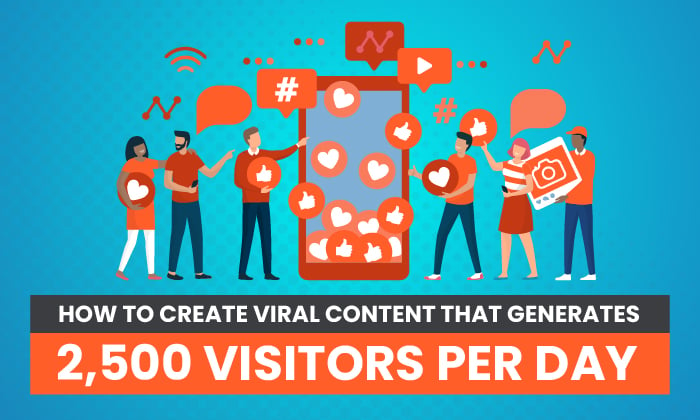
Ever wondered how content goes viral? You’re not alone.
In fact, it’s what we’re all aiming for as content marketers. After all, what company doesn’t want to see thousands of people sharing and enjoying their content?
The good news is that “viral status” is totally achievable. It’s not something you need to leave to chance, but you don’t need to be a content marketing expert to create viral content, either.
Instead, you just need to know how viral content works.
You need to understand what makes content inherently shareable and apply that knowledge to your own campaigns.
With that in mind, let me introduce you to the intriguing world of viral content and show you how to make a success of your marketing campaigns.
What Is Viral Content?
Viral content spreads rapidly (like, well, a virus).
It’s designed for circulation. People view the material, love it, and share it across social media. Before you know it, hundreds of thousands, if not millions, of people are engaging with your content.
What type of content can go viral, though? Well, it can be anything: an image, video, article, or even just a catchy slogan. What matters is that it’s unique, shareable, and memorable for all the right reasons.
How Can Viral Content Drive My Marketing ROI?
Viral content is marketing that pays for itself.
Think of it this way: You create content, and then it’s shared widely around the internet.
Although you can run a paid ad campaign if you want, it might not be necessary because all these individuals are sharing your content online for free.
As a result, you can save money on marketing and, therefore, boost your ROI.
Does viral content sound like it’s worth giving a shot? I think so!
How to Create Viral Content That Drives Traffic
Honestly, there’s no guarantee any content you create will go viral. However, you can do different things to maximize your chances of running a viral digital marketing campaign. With that in mind, here are seven steps to work through if you want to give your content a shot at going viral.
1. Start With Research
You can’t hope to make viral content if you don’t have a solid plan in place for making it happen.
First, set a goal. Whether you want 100,000 followers or you hope 100,000 people watch your video, set a concrete goal and work from there.
Then, figure out what your audience likes. Where do they hang out? What type of content do they like, share, and engage with the most? Use your answers to determine where to start your campaign and what medium to use (e.g., images or text).
Finally, check out past examples of viral content from your competitors. Figure out what made the content so successful and aim to deliver something even better.
2. Be Different
What does all viral content have in common? It’s original and authentic in some way. It delivers the unexpected.
Here’s a great example. You wouldn’t usually expect a police force to post “fun” content, and yet, the NSW Police Force delivers. The officers make themselves relatable to younger people by using wit and humor to drive home the importance of, for example, fraud detection:
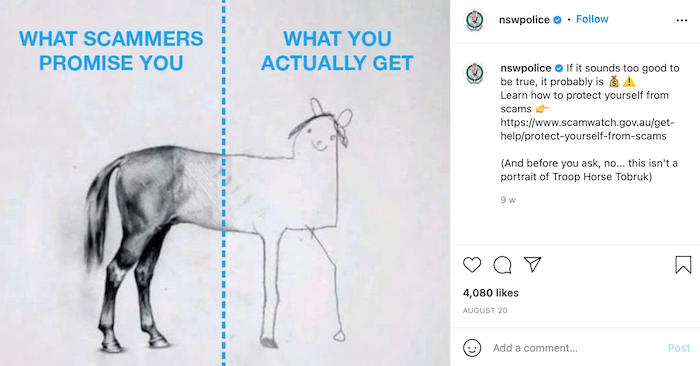
The NSW Police Force uses a unique approach to foster community relations and build audience trust. This strategy has earned them an active follower base and engagement rate.
The take-home message here? Don’t be afraid to be a little different.
3. Hook Your Users
Your hook is your concept. It’s why people stop and pay attention to your content. It’s why those same people share your content with their social networks.
In other words, your hook is your content’s unique selling proposition (USP). A hook should:
- convey a clear message
- appeal to your intended audience
- encourage your target consumer to engage further with your content
Think of your hook as bait. It captures your audience’s attention and lures them into taking the desired action like visiting your website, signing up for more content, or following you on social media.
The type of hook you use varies depending on the content medium. For example, every video needs a great intro and thumbnail, an article needs a catchy headline, and images often benefit from cool taglines.
In every case, though, less is usually more. Don’t overthink your hook. Stay true to your brand voice, promote a consistent brand image, and let your company’s personality shine through.
4. Get Visual
If you want a viral campaign, you need visuals.
What are you more likely to share on social media: an article with walls of unbroken text, or an image with a cool caption?
Unless you’re dealing with a niche audience, chances are you’ll share the image first. Why? Well, visual content is easily consumable. It’s fun. Ultimately, although you’re trying to inform your audience, you also want to entertain them.
Think back to our example of the NSW Police Force. What do you think works best for their intended audience: a serious article on scam statistics, or a fun graphic emphasizing the importance of scam detection?
Here’s another example from their account to show you what I mean:
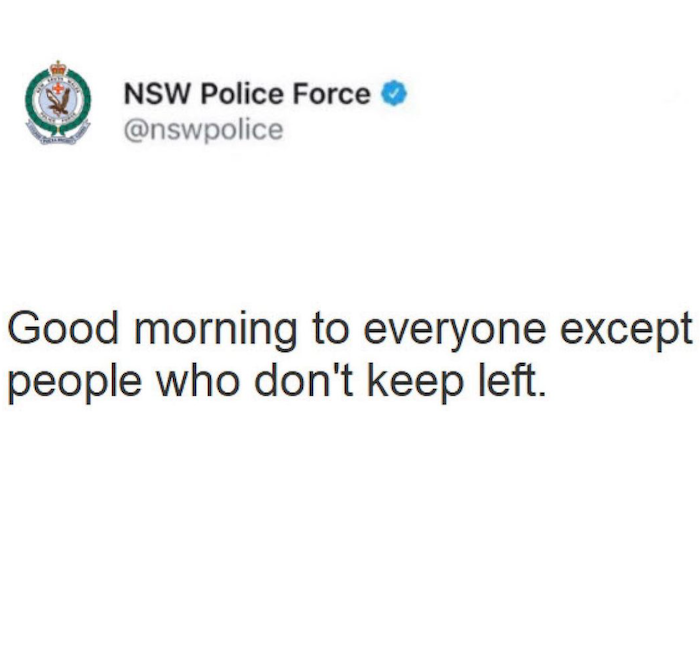
Sure, you need to provide content of value, especially if you’re a service provider. Just remember to get creative in how you deliver this information if you want to go viral.
5. Create a Promotional Plan
Sure, sometimes content goes viral by accident. UK brand White Claw, for example, went viral after a popular YouTuber shot a video around drinking the hard seltzer product:
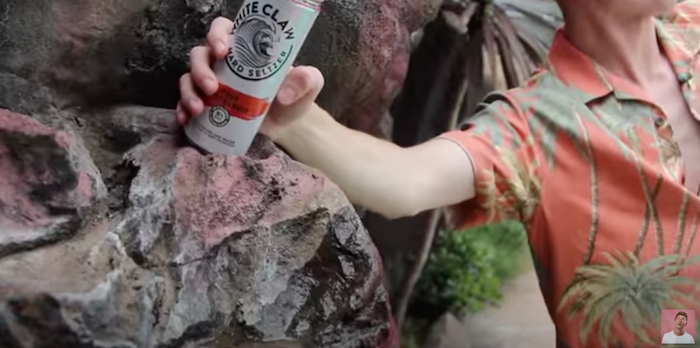
However, there’s no guarantee this will ever happen to your brand’s content, which is why you need a solid plan for promoting your content and sharing it widely. Here are some ideas for planning your strategy.
First, think back to your content goal. Maybe you want to get over 500,000 video views, promote an underselling product, or boost your brand’s presence online. Return to your goal and strategize from there.
Next, answer this question: Where is your audience? For example, maybe your audience loves sharing videos on Instagram and YouTube, or perhaps they favor hard-hitting news pieces. Focus on sharing content on the platforms where your audience is most likely to find it.
Then, consider your budget. Can you afford a paid ad campaign, or will you rely on organic shares?
To be clear, you don’t need to run paid ad campaigns; after all, there’s no guarantee they’ll help you go viral. However, if you’re in a competitive niche, you might find a paid campaign or two will help you stand out.
Finally, decide how long your campaign should run. Will it run for just a few weeks, or are you planning a three-month campaign? There’s no right answer, by the way. It just depends on your specific objectives.
In short? Think of your plan as a map for helping you reach your destination—viral status. While there’s no need to stick to it diligently, let it guide you towards where you want to go.
6. Measure Your Success
OK, so you’ve launched your campaign, and you’re going for viral status. How do you track your progress to check if you have reached your goal?
By measuring your performance, that’s how. There are a few programs you can use for this purpose, such as Google Analytics, social media analytics, and content marketing tools. It all depends on where you run your campaign and what platform you’re most comfortable working with.
What measurements should you track? It depends on your campaign, but you’ll probably want to track, for example, how many times people share your content on social media and on which platforms people share your content the most.
You’ll also want to track how often people share your links around the internet. A tool like LinkTrackr is helpful for this. Not only can you track how far people are sharing your links around the world, but you can track your entire sales funnel from start to finish:
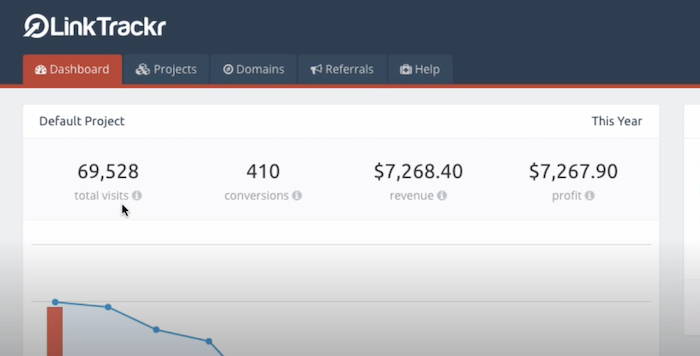
You might also look at the number of impressions you have, which is basically how many times different people see your content (although this number won’t tell you much without tracking the metrics above).
7. Try Again
Remember, even if you run one viral campaign, you can’t rest on your laurels. Instead, focus on making your next campaign just as effective.
Start by evaluating your successful campaign. Analyze what worked and use this data to inform your next content stream. You can use the measurements you figured out earlier for this purpose.
Next, think about your brand story. How can you create more viral content that reinforces the brand message you projected with your first campaign? An audience values consistency because it makes a brand seem more authentic, so always play to your strengths and highlight your core values.
What if your content didn’t go viral? Don’t think of it just as a failed campaign. Instead, see it as a learning opportunity:
- First, consider your strategy: Was there a clear campaign strategy in place with a defined goal? Without a goal, you risk running an aimless marketing campaign that is unlikely to go viral.
- Next, review your understanding of your target audience: Did you misread their likes and dislikes, or did you target them on the wrong platform? Next time, research your audience more thoroughly.
- Finally, check out any trends in audience feedback: Did your article fail to deliver on a promising headline? Was there anything off-putting or even offensive about your content? While you can’t please everyone, make sure you take any recurring themes seriously.
Creating Viral Content: Frequently Asked Questions
Ready to go viral? Here’s a quick summary of the key points I covered earlier to help you ace your next marketing campaign.
What is viral content?
Viral content is simply any content that is shared widely across the internet in a few hours or so. In other words, it’s content that becomes popular very quickly. Any type of content can go viral, from memes to news articles.
How do I make my content go viral?
First, you need a goal. Know your target audience, figure out what speaks to them, and create content with a unique “hook” to pique their interest. Viral content often has a visual element, so consider including a video, image, or GIF of some kind.
Do I need paid ads to create viral content?
No. While some paid ads can go viral, running a paid ad campaign is no guarantee that you’ll create viral content. Focus on creating cool content and, if you have the marketing budget, run paid ad campaigns to help increase your chances of going viral.
What are the benefits of viral content for my business?
Viral content helps you reach new people, spread your brand message, and boost your credibility in a short amount of time. What’s more, when people share your content online, it’s essentially free advertising. Doesn’t free advertising sound great? I think so.
How to Create Viral Content: Conclusion
OK, so there’s no magic formula for creating viral content. However, you can boost your chances of going viral by researching your audience first.
Figure out what makes them tick and what makes a piece of content “shareable.” Check out examples of viral content from creators in your industry and identify what made them so popular. What can you learn from past successful campaigns, and how can you create something that’s even better?
Don’t let the content creation process overwhelm you. If you’re struggling to find your inspiration or you need some help setting clear marketing goals, check out my consulting services for more help.
Have you ever created viral content before? How did the viral campaign help your business?
from Blog – Neil Patel https://ift.tt/3Iwm4gd
via IFTTT
No comments:
Post a Comment